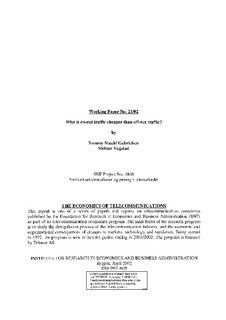| dc.contributor.author | Gabrielsen, Tommy Staahl | |
| dc.contributor.author | Vagstad, Steinar | |
| dc.date.accessioned | 2006-07-18T16:25:20Z | |
| dc.date.available | 2006-07-18T16:25:20Z | |
| dc.date.issued | 2002-04 | |
| dc.identifier.issn | 1503-2140 | |
| dc.identifier.uri | http://hdl.handle.net/11250/166536 | |
| dc.description.abstract | Received literature have shown that if competing Telecom networks are restricted to linear pricing and are unable to discriminate between on- and off-net calls, high access charges can be a device for facilitating collusion. Under more general pricing schemes (allowing non-linear pricing and price discrimination between on-net and off-net traffic) high access charges are more difficult to sustain, because they reduce consumers' willingness to pay fixed fees. We show that an unbalanced calliing pattern is sometimes sufficient to restore high access charges as an equilibrium outcome. | en |
| dc.format.extent | 782960 bytes | |
| dc.format.mimetype | application/pdf | |
| dc.language.iso | eng | en |
| dc.publisher | SNF | en |
| dc.relation.ispartofseries | Working Paper | en |
| dc.relation.ispartofseries | 2002:23 | en |
| dc.subject | two-way access | en |
| dc.subject | non-linear pricing | en |
| dc.subject | competition | en |
| dc.title | Why is on-net traffic cheaper than off-net traffic? | en |
| dc.type | Working paper | en |
